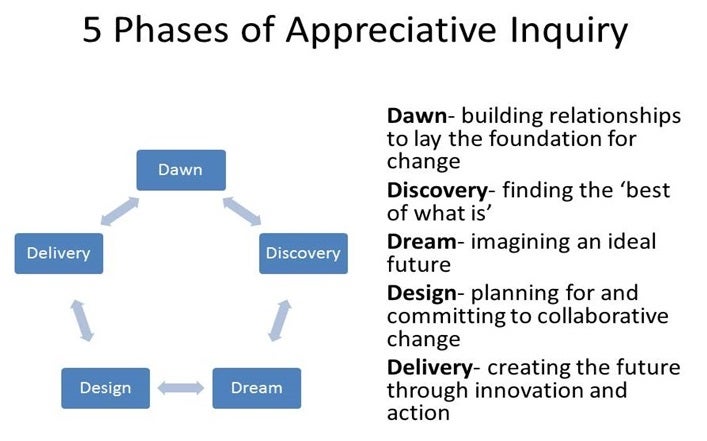Overview
Appreciative Inquiry was chosen for the project because it is a research methodology that moves away from problem-oriented, deficit-based approaches. Rather than focusing on “what is wrong”, Appreciative Inquiry looks at bringing forward the strengths of a community or organization, to begin envisioning possibilities for the future.
Appreciative Inquiry fact sheet (PDF)
The following quotes demonstrate the power of focusing on strengths:
|
Traditional problem-oriented approach |
Appreciative approach |
|
Focus on what’s wrong; search for root causes of failures |
Focus on what works; search for root causes of success |
|
Obstacles treated as barriers |
Obstacles treated as ramps into new territory |
|
If you look for problems, you’ll find (and create) more problems |
If you look for successes, you’ll find (and create) more successes |
|
Can lead to blaming |
Can lead to greater creativity |
|
De-energizing |
Energizing |
A new first phase
Typically, the Appreciative Inquiry process has four phases. The PiDC Alliance research team has created a new first phase of the process, called Dawn.
Alongside Culture Change Coalition (CCC) members, Alliance researchers recognized the need to include a phase in the process where coalitions have the opportunity to establish themselves, determine the expectations and philosophies guiding their work, and to learn about the process, underlying principles, and each other.
In short, it was realized that the Culture Change process works best when we devote time to creating strong Authentic Partnerships before beginning the work of data collection. This is the hallmark of the PiDC Alliance approach to Culture Change.
PiDC Alliance Five Phases of Appreciative Inquiry

-
Dawn During Dawn, the Culture Change Coalitions work to build rapport and trusting relationships along with the skills and knowledge needed to work collaboratively through authentic partnerships. The Appreciative Inquiry journey asks people to move away from ‘traditional’ decision making and make suggestions for change that are provocative, bold and creative. For people to feel comfortable in doing that - building strong trusting relationships with one another is critical.
-
Discovery In this phase of the process, each Culture Change Coalition reflects on the positive experiences, or the best of what is within their community or organization. During the Discovery phase, the group gathers positive stories from key stakeholders about what gives the community or organization life.
-
Dream There are few limitations in this phase of the Appreciative Inquiry process. Coalition members are encouraged to reflect on the positive data that they have collected in the Discovery phase, about what works well, and importantly, what is going on when things are going well, and imagine the possibilities for the future. By the end of Dream, each of the Culture Change Coalitions will create aspiration statements for their culture change process. These statements describe and drive the design of the future actions of the group or organization.
-
Design During this phase the group works to move on from the provocative aspiration statements of the Dream stage. Culture Change Coalitions develop and commit to an action plan with the purpose of beginning to realize the aspiration statements that were developed in Dream.
-
Delivery Each Culture Change Coalition works within the organization or community setting to creatively support and sustain the action plan created in the Design phase.
It’s important to recognize that organizations don’t generally move through the 5 steps in an orderly sequence. Sometimes earlier stages need to be revisited as new people become involved in the process or new learning takes place that challenges earlier understandings. And often one stage will overlap another.
Some organizations have experimented with accelerating the process by involving diverse groups of stakeholders in focused, bursts of activity. For instance, after engaging people in the Dawn and Discovery steps, an organization might choose to hold one or more workshops that will allow stakeholders to work through the Dream and Design phases in a shorter period of time than they might if they held shorter meetings spread over many months.
However the Appreciative Inquiry process is used, it’s important to stick to the principles of Authentic Partnerships throughout.
Eight Assumptions of Appreciative Inquiry
You may find it useful to consider the Assumptions of Appreciative Inquiry when thinking about how to plan and share knowledge about the Appreciative Inquiry process with your group or organization.
Sue Annis Hammond's The Thin Book of Appreciative Inquiry outlines the 8 Assumptions of the Appreciative Inquiry Process. These assumptions are powerful tools in understanding and sharing the Appreciative Inquiry process. These are quoted in full below.
- In every society, organization or group, something works.
- What we focus on becomes our reality.
- Reality is created in the moment, and there are multiple realities.
- The act of asking questions of an organization or a group influences the group in some way.
- People have more confidence and comfort to journey to the future (the unknown) when they carry forward parts of the past (the known).
- If we carry parts of the past forward, they should be what is best about the past.
- It is important to value differences.
- The language we use creates our reality.
---Annis Hammond, 1998, p. 20-21
We have found that considering these assumptions during the Appreciative Inquiry process is a useful way of ensuring that language stays appreciative! For more information refer to: How to keep things appreciative.
Reference
Annis Hammond, S. (1998). The thin book of appreciative inquiry. 2nd ed. Thin Book Publishing Company: Bend, OR.